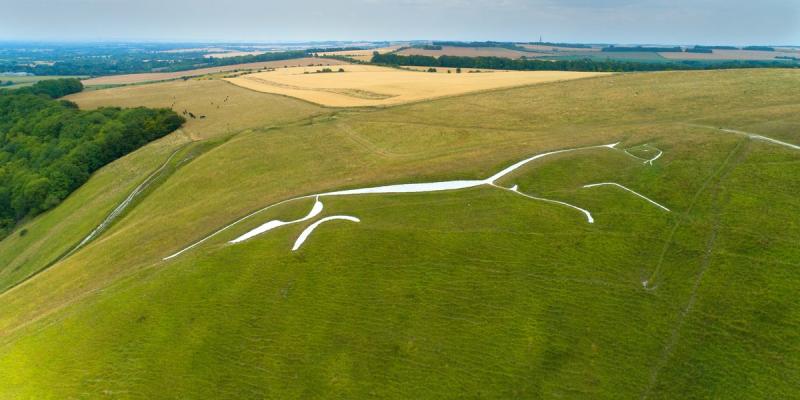Against All Odds, England's Massive Chalk Horse Has Survived 3,000 Years
By: Pocket


The White Horse at Uffington, Oxfordshire. Photo by Philippe Turpin / Getty Images.
If you stand in the valley near the village of Uffington in Oxfordshire, England, and look up at the high curve of chalk grassland above you, one thing dominates the view. Across the flank of the hill runs an enormous white, abstract stick figure horse cut from the chalk itself. It has a thin, sweeping body, stubby legs, a curiously long tail and a round eye set in a square head.
This is the Uffington White Horse, the oldest of the English hill figures. It's a 3,000-year-old pictogram the size of a football field and visible from 20 miles away. On this July morning black specks dot the lower slopes as small groups of people trudge slowly upwards. They're coming to clean the horse.
It's chalking day, a cleaning ritual that has happened here regularly for three millennia. Hammers, buckets of chalk and kneepads are handed out and everyone is allocated an area. The chalkers kneel and smash the chalk to a paste, whitening the stony pathways in the grass inch by inch. "It's the world's largest coloring between the lines," says George Buce, one of the participants.
Chalking or "scouring" the horse was already an ancient custom when antiquarian Francis Wise wrote about it in 1736. "The ceremony of scouring the Horse, from time immemorial, has been solemnized by a numerous concourse of people from all the villages roundabout," he wrote.
In the past, thousands of people would come for the scouring, holding a fair in the circle of a prehistoric fort nearby. These days it's a quieter event. The only sounds are the wind, distant birdsong and the thumping of hammers on the chalk that can be felt through the feet.
Conservation organization the National Trust oversees the chalking, making sure the original shape of the horse is maintained. But the work is done by anyone who wants to come along. Lynda Miller is working on the eye, a circle the size of a car wheel. "The horse has always been part of our lives," she says. "We're really excited that we're cleaning the eye today. When I was a little girl and I came here with my mother and father, the eye was a special spot. We used to make a wish on it."
National Trust ranger Andy Foley hands out hammers. "It must have happened in this way since it was put on the hillside," he says. "If people didn't look after it the horse would be gone within 20 to 30 years; overgrown and eroded. We're following in the footsteps of the ancients, doing exactly what they did 3,000 years ago."
"There is something very special about this landscape that attracts people," says archaeologist David Miles. In the 1990s, he led an excavation of the site that established the prehistoric date for the horse. Before the excavation, it was thought that the design was only scratched into the chalk surface, and therefore un-datable, but Miles' team discovered the figure was actually cut into the hill up to a meter deep. That meant it was possible to use a technique called optical stimulated luminescence to date layers of quartz in the trench.
"It was older than I'd been expecting," Miles remembers. "We already knew it must be ancient, because it's mentioned in the 12th-century manuscript The Wonders of Britain , so it was obviously old then. And the abstract shape of the horse is very similar to horses on ancient British coins just over 2,000 years old. But our dating showed it was even older than that. It came out as the beginning of the Iron Age, perhaps even the end of the Bronze Age, nearly 3,000 years ago."
The trenches would have been dug out using antler picks and wooden spades: tough, labor-intensive work. How the builders planned and executed such a large figure when the full effect can only be taken in from several miles away is still a mystery.
Nobody knows for certain why the horse was made. "It's a beautiful shape, very elegant," says Miles. "It looks like it's bounding across the hillside. If you look at it from below, the sun rises from behind it and crosses over it. In Celtic art, horses are often shown pulling the chariot of the sun, so that may be what they were thinking of here."
From the start the horse would have required regular upkeep to stay visible. It might seem strange that the horse's creators chose such an unstable form for their monument, but archaeologists believe this could have been intentional. A chalk hill figure requires a social group to maintain it, and it could be that today's cleaning is an echo of an early ritual gathering that was part of the horse's original function.
The Berkshire Downs where the horse lies are scattered with prehistoric remains. The Ridgeway, Britain's oldest road, runs nearby. This is the heart of rural England and the horse is one of the country's most recognizable landmarks, an identity badge stamped into the landscape. During World War II, it was covered over with turf and hedge trimmings so Luftwaffe bombers couldn't use it for navigation. (Oxford is about a 30-minute drive and London about an hour-and-a-half.)
For locals, it's part of the backdrop of daily life. Residents in the village reportedly arrange their rooms so that they sit facing the horse. Offerings, flowers, coins and candles are left on the site.
The people who come to the chalking have a variety of motivations. Martha Buckley is chalking the horse's neck. " I'm a neo-Pagan and I feel it connects me to the land. It's of great spiritual significance," she says. Lucy Bartholomew has brought her children. "It's good to be able to explain to them why it's here." For Geoff Weaver, it's the imperative to preserve history. "If we don't do it, it would disappear, and the world would be a sorrier place," he says.
Up on the hill it's not possible to view the whole horse at once; the curve of the slope gets in the way, the sheer scale of it confuses the eye. It is only from the valley below that the whole picture can be taken in. From this long distance, the horse is a tiny white figure prancing timelessly across the brow of the hill. But to the people who live near and tend the horse, it's a monumental reminder of Britain's ancient past.

 Article is LOCKED by moderator [Split Personality]
Article is LOCKED by moderator [Split Personality]





Only in England.
Can't see it happening on this side of the pond.
No politics please
Hell, we would have destroyed it in the name of progress.
progress? I'm thinking more like for profit.